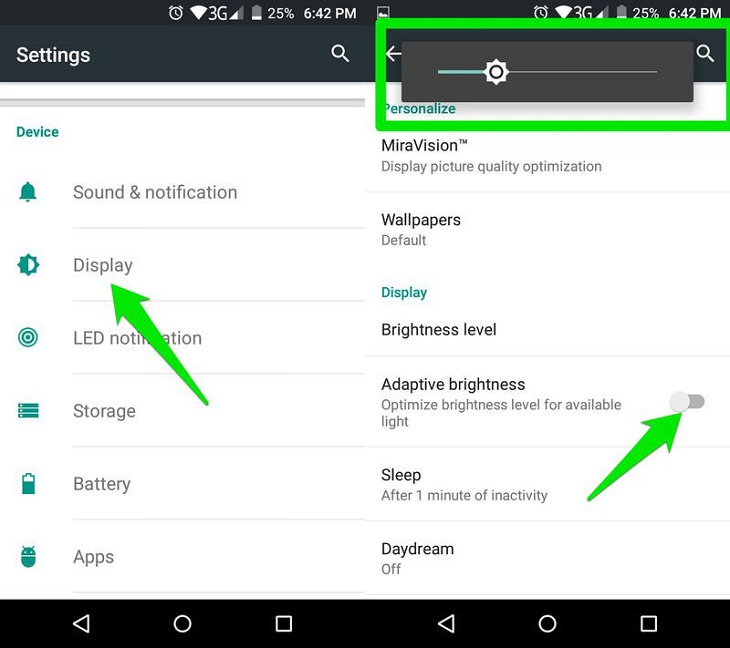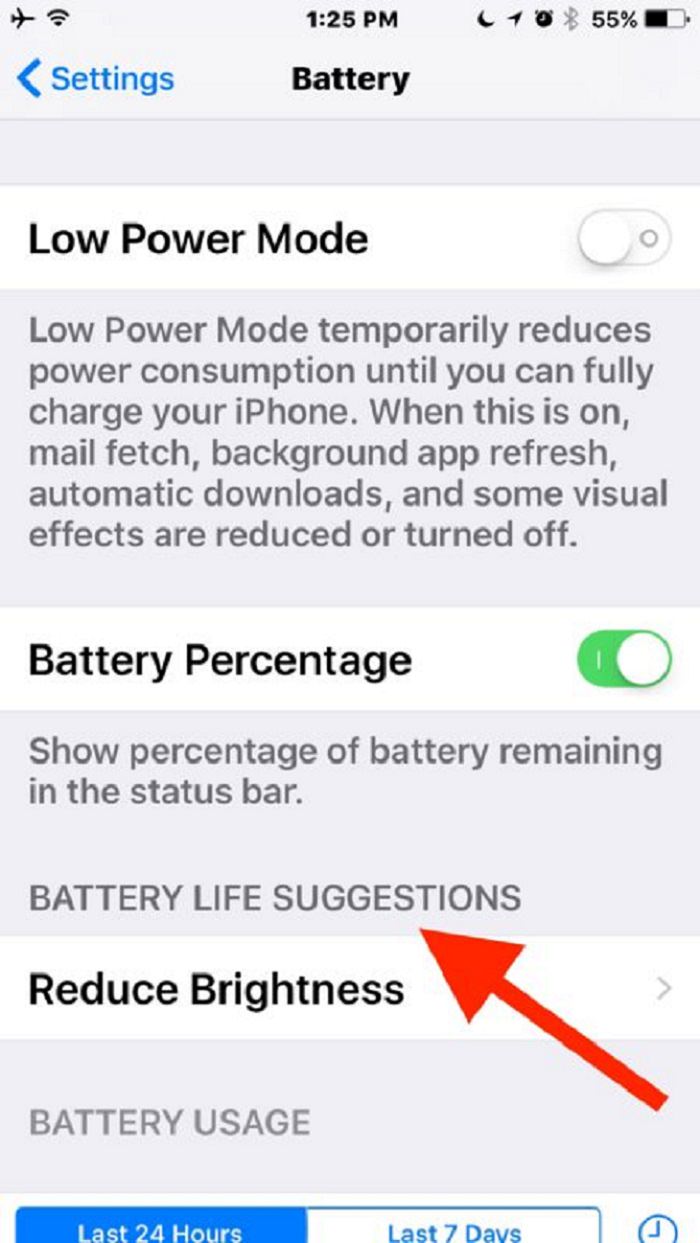
Short battery life is one of the biggest downfalls of Android and iOS 10 phones, and there will be times when you won't have access to a charging point when this inconvenient moment arises. Thankfully, we know some very handy ways to decrease battery usage, and enable your phone to survive on low battery for a decent period of time.
There are some physical tweaks that could give you more juice out of that 10-15% battery power that you have left. Naturally, these tweaks may limit some other features on the phone, but this shouldn't really matter as your ultimate aim is to save your phone's battery.
Below are 6 separate tips for Android and iOS 10 that'll enable you to live through a dying battery.
Android

Most android phones nowadays have a built-in system which enables you to check which phone components and apps are using the most battery. You can use this information to pinpoint the app that is using the most battery and disabling it (if possible).
1. Go to "Settings" and tap on "Battery" option.
2. You should see a graph with the apps that are draining your battery (tap on the graph if apps are not showing).
3. Cellular signals, Wi-Fi signals, and Screen will more than likely be on top of the list.
Your focus here is to look for rogue apps or processes that may be draining your battery. If you do find such an app, disable it if possible. We explain how to do this in the next tip.
2. Stop Running Apps
A large percentage of apps keep running in the background even if they are not being used. An example of this is instant messaging apps that run in the background so that they can notify you about new messages. If you currently have no need for this, you can turn these apps off to increase battery life.
1. Go to "Settings" and tap on "Apps".
2. Swipe left to move to the "Running " tab and you will see all the background apps.
3. Tap on the ones you don't want to run in the background and select "Stop".
Note: Make sure you only stop the apps that are not needed by the system, such as third-party apps.

Screen brightness eats up a lot of battery power. If you're actively using your phone, then turning down the brightness will help you get a whole lot more out of your battery. Usually, you can adjust the brightness from the notification bar, but you can also go to Settings > Display to adjust it.
If you're in an area with low light, then turning the brightness down as low as it goes should be enough to save some good battery power. Otherwise, adjust it to the point where you can just see the screen's content.
Furthermore, you should disable the "Automatic Brightness" feature if you haven't done so already. This feature automatically adjusts your phone's brightness according to the light conditions in your surroundings.
4. Turn Off Cellular Signals
Cellular signals are one of the biggest battery hogs, especially if you find yourself in an area where your phone struggles to get signals. If you're not expecting an important call, text message, or using mobile internet data, then we recommend that you turn off cellular signals.
1. From the "Settings", go to "SIM Settings" and turn off the signals to your SIM.
2. If you have dual SIM, then turn off signals to both.
3. You may also be able to do this from the notification bar.

WiFi signals are also a major contributor to a drained battery, even when you're not using it. Therefore, if you don't need WiFi, simply bring down the notification bar and turn off the WiFi signals.
However, this does not mean that you should replace WiFi with internet data, as this will drain even more battery.
The location services in your Android phone uses cellular signals, WiFi signals, and GPS, so you can only guess at how much power you might be losing. Many apps and Google services use location data. However, you don't need location based services all the time and you should disable them when you're running out of battery.
To do so, go to "Settings" and then tap in "Location". Here, tap on the green switch in the top right corner to turn off location data.
6. Use the Built-In Battery Power Saver
Most Android phones come with a battery power saver mode which puts the phone in a state where it uses the least battery. Battery saver mode turns off GPS location, auto-sync, background services, and decreases your phone's performance to increase battery life.
In this mode, you may even get multiple hours of uptime in standby mode, and you will still be able to use cellular and Wi-Fi services.
Usually, the phone will prompt you to switch to battery saver mode along with the low battery prompt. However, if you want to do it manually, follow these steps:
1. Go to "Settings" and tap "Battery".
2. All battery power saving options can be found here.
3. Read the description and choose the preferred one.
iOS 10

If you haven't been making use of iOS' built-in Low Power Mode, then now would be a great time to acquaint yourself with this great feature. This feature allows you to stretch out the last 10-20% of battery life on your device without having to make a load of manual changes. It could give you up a few hours extra battery life.
To turn on Low Power Mode on your device, go to Settings > Battery > Low Power Mode > On.
2. Disable iCloud Keychain
If you don't make use of iCloud Keychain, disabling it may help to improve your battery life.
To disable this feature on your device, go to Settings > iCloud > Keychain > Toggle iCloud Keychain Off.

iOS, like Android, has a terrific battery usage utility that shows you exactly which apps and services are using your battery and how.
1. Launch "Settings" from your Home screen.
2. Tap on "Battery".
3. Wait a moment for "Battery Usage" to populate.
4. Tap on the "Show Detailed Usage" option (this will give you a breakdown of background and foreground power usage).
5. Tap on "Last 7 Days" to get a wider look at your power consumption over time.
This can be tricky to understand at first, but here's the deal: If you see iCloud Photo Library there, and you've just upgraded, it shows that you're downloading thumbnails and things should return to normal when the downloads have finished. However, if you see Facebook there and it says 4% on screen and 40% on background, it's a sure sign that something has gone wrong.
At this point, you can force quit a rogue app and get you power consumption back to normal:
1. Double tap the "Home" button to bring up the fast app switcher.
2. Swipe to the "app" you want to force quit.
3. Touch the "app" card and flick it up and off the screen.
To disable this feature on your device, go to Settings > iCloud > Keychain > Toggle iCloud Keychain Off.
4. Use Airplane Mode
If you suddenly start experiencing rapid battery drain it could be because you're in an area with a weak cellular coverage. When you're in a bad service area, your iPhone will work a lot harder in order to find a signal. This will cause your battery to drain more rapidly. Therefore, this is the perfect time to flip on Airplane Mode.
Airplane mode is found at the very top of your Settings and turning it on will kill all of your connections. If you've traveled in a plane over the past few years, you're probably already familiar with this feature. Once you are back in an area with decent cellular coverage, turn Airplane Mode off.

New to iOS 10 is the ability of the device to recommend battery saving suggestions to prolong your battery life. Typically this means making adjustments to usage like reducing the device's screen brightness.
Go to Settings > Battery > look for "Battery Life Suggestions".
See what your device is telling you, and follow that advice. You can tap on each item in order to jump directly to it in Settings.
6. Manage Your Display
Apple mobile devices, like some Android devices, use sensors that automatically adjust the brightness of the screen according to the light present in the environment. A bright screen eats up battery life so we recommend getting a handle on your device's display.
First, try turning "Auto Brightness" off. To do so, go to Settings > Display and Brightness > Auto-Brightness > Off. Once it has been turned off, you'll just need to adjust your screen manually. To do this, swipe up from the bottom of the screen to bring up "Control Center". You will see a bar that stretches across the length of the first Control Center card - use this to adjust your screen brightness.
Sources: hongkiat, imore, gottabemobile and osxdaily